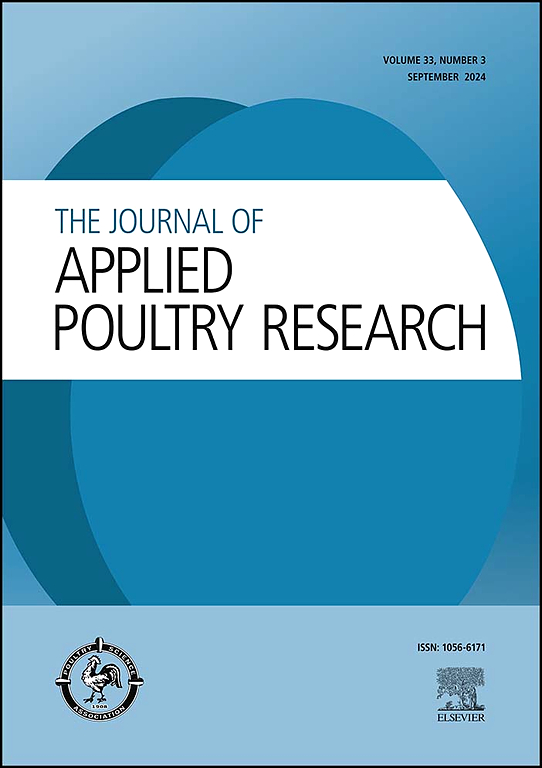酸化粘土和硫酸氢钠对凋落物氨、pH、好氧平板总数和肉鸡脚垫皮炎的影响
IF 2
3区 农林科学
Q2 AGRICULTURE, DAIRY & ANIMAL SCIENCE
引用次数: 0
摘要
酸化粘土和硫酸氢钠是常用的凋落物改良剂,用于控制家禽凋落物中的氨和较低的pH值。通过3个单独的栏试验,比较两种添加剂在控制商品肉鸡窝产氨、pH、总需氧平板计数(APC)和改善脚垫病变方面的效果。选择一个商业肉鸡研究农场作为试验场地。将日龄肉鸡放在40个栏中(每栏60只,共2400只),放置在用过的松屑上。钢笔被锁在房子里。在放置笔之前,需要将笔去除结块并进行顶部修饰。处理包括(1)对照;(2)酸化粘土和(3)硫酸氢钠。在每个围栏收集复合凋落物表面样品,并于第0-5天分析pH和APC。第0 ~ 5天测定凋落物表面氨浓度。在第3天和第6天记录氨通量测量。第38天评估肉鸡脚垫病变评分。处理凋落物的氨、pH、总APC和氨通量值显著低于对照。酸化粘土组氨浓度显著低于亚硫酸氢钠组。第1天,酸化粘土处理凋落物的pH值和总APC值低于硫酸钠处理凋落物。与酸化粘土组和亚硫酸氢钠组相比,对照组在笔内的平均脚垫损伤评分明显更高。此外,与酸化粘土组相比,硫酸氢钠组的平均脚垫损伤评分明显更高。事实证明,这两种窝料添加剂都能有效控制氨、pH、总APC和改善脚垫皮炎,从而提高肉鸡饲养效率、生产力和肉鸡爪的适销性。本文章由计算机程序翻译,如有差异,请以英文原文为准。
Impact of acidified clay and sodium bisulfate on litter ammonia, pH, total aerobic plate counts and broiler footpad dermatitis
Acidified clay and sodium bisulfate are common litter amendments utilized to control ammonia and lower pH in poultry litter. Three separate pen trials were conducted to compare the efficacy of both amendments for controlling litter ammonia, pH, total aerobic plate counts (APC), and improving footpad lesions in commercial broilers. A commercial broiler research farm was chosen as the test site. Day-old broiler chicks were placed in 40 pens (60 per pen for a total of 2400 birds) on used pine shavings. Pens were blocked within the house. Prior to placement pens were de-caked and top dressed as necessary. Treatments consisted of (1) control; (2) acidified clay and (3) sodium bisulfate. Composite litter surface samples were collected from each pen and analyzed for pH and APC on days 0-5. Litter surface ammonia concentrations were measured on days 0-5. Ammonia flux measurements were recorded on days 3 and 6. Broiler footpad lesion scores were assessed on day 38. Ammonia, pH, total APC and ammonia flux values were significantly lower in treated litter compared to values in the control. Ammonia concentrations in the acidified clay group were significantly lower than values in the sodium bisulfate group. On day 1, pH and total APC values in the acidified clay treated litter were lower than values in the sodium bisulfate treated litter. Average footpad lesion scores within a pen were significantly higher in the control group as compared to the acidified clay and sodium bisulfate groups. Additionally, average footpad lesion scores were significantly higher in the sodium bisulfate group as compared to the acidified clay group. Both litter amendments proved effective for controlling ammonia, pH, total APC and improving footpad dermatitis, supporting greater broiler rearing efficiency, productivity, and marketable broiler paws.
求助全文
通过发布文献求助,成功后即可免费获取论文全文。
去求助
来源期刊

Journal of Applied Poultry Research
农林科学-奶制品与动物科学
CiteScore
4.10
自引率
10.50%
发文量
80
审稿时长
104 days
期刊介绍:
The Journal of Applied Poultry Research (JAPR) publishes original research reports, field reports, and reviews on breeding, hatching, health and disease, layer management, meat bird processing and products, meat bird management, microbiology, food safety, nutrition, environment, sanitation, welfare, and economics. As of January 2020, JAPR will become an Open Access journal with no subscription charges, meaning authors who publish here can make their research immediately, permanently, and freely accessible worldwide while retaining copyright to their work. Papers submitted for publication after October 1, 2019 will be published as Open Access papers.
The readers of JAPR are in education, extension, industry, and government, including research, teaching, administration, veterinary medicine, management, production, quality assurance, product development, and technical services. Nutritionists, breeder flock supervisors, production managers, microbiologists, laboratory personnel, food safety and sanitation managers, poultry processing managers, feed manufacturers, and egg producers use JAPR to keep up with current applied poultry research.
 求助内容:
求助内容: 应助结果提醒方式:
应助结果提醒方式:


